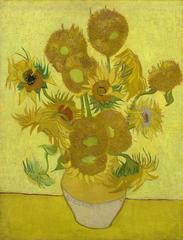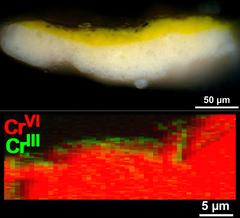URL: https://www.desy.de/news/news_search/index_eng.html
Breadcrumb Navigation
[LgDashBoard2@/e409/e116959/e119238][getObjProperty]: key=title[py] Traceback (most recent call last): File "/home/zeoclients/parts/products/zms/_objattrs.py", line 679, in getObjProperty value = metaObjAttr['py'](zmscontext=self) File "/home/zeoclients/parts/zope2/lib/python/Shared/DC/Scripts/Bindings.py", line 313, in __call__ return self._bindAndExec(args, kw, None) File "/home/zeoclients/parts/zope2/lib/python/Shared/DC/Scripts/Bindings.py", line 350, in _bindAndExec return self._exec(bound_data, args, kw) File "/home/zeoclients/parts/zope2/lib/python/Products/PythonScripts/PythonScript.py", line 328, in _exec result = f(*args, **kw) File "Script (Python)", line 6, in LgDashBoard2.title UnicodeDecodeError: 'ascii' codec can't decode byte 0xe2 in position 12: ordinal not in range(128)
News
News from the DESY research centre
Why van Gogh’s Sunflowers are wilting
The colour of Vincent van Gogh’s famous Sunflowers is changing over time, because of the mixture of pigments used by the Dutch master in his painting. Evidence for the process now comes from a detailed spectroscopic investigation of the Sunflowers version at the Van Gogh Museum in Amsterdam. A group of scientists headed by Letizia Monico from the Institute of Molecular Science and Technology (CNR-ISTM) of Perugia, the University of Perugia and the University of Antwerp shone X-rays from DESY’s lightsource PETRA III through tiny particles of paint taken from the painting. They describe their results in the journal Angewandte Chemie International Edition. The study also identifies areas of the painting that should be monitored particularly closely for any changes.

Sunflowers, 1889, Vincent van Gogh (1853-1890). Credit: Van Gogh Museum, Amsterdam (Vincent van Gogh Foundation) - http://www.vangoghmuseum.nl/en/collection/s0031V1962
The scientists examined a Sunflowers painting, which dates back to 1889, to determine whether van Gogh had used different types of chrome yellow when painting it. He produced three versions of the painting, one of which is on display at the National Gallery in London, one at the Seji Togo Memorial Sompo Japan Nipponkoa Museum of Art in Tokyo and one at the Van Gogh Museum in Amsterdam. Two small paint samples, measuring less than 1 millimetre each, were taken from the painting in Amsterdam and examined using DESY’s X-ray source PETRA III. “The analysis shows that the orange-yellow hues mainly contain the lightfast version of chrome yellow, whereas the light-sensitive type is mainly found in the pale yellow areas,” reports co-author Gerald Falkenberg, who is in charge of DESY’s beamline P06, where the X-ray diffraction measurements were carried out.

Top: Micrograph of a paint sample taken from the table area (lower edge) of the Sunflowers painting. Credit: The Netherlands Cultural Heritage Agency, RCE, Amsterdam. Bottom: At the very surface of the exposed chrome yellow paint, a change of colour has taken place, as CrIII compounds (green) replaced yellow-orange chromates (containing CrVI, red). Credit: Letizia Monico et al.
The scientists used a mobile scanner to identify those parts of the painting which ought to be monitored particularly closely for possible changes. “Since chrome yellow pigments were widely used by late 19th-century painters, this study also has broader implications for assessing the colours of other works of art,” emphasises co-author Koen Janssens, from the University of Antwerp.
Reference:
Evidence for Degradation of the Chrome Yellows in Van Gogh's Sunflowers: A Study Using Noninvasive In Situ Methods and Synchrotron-Radiation-Based X-ray Techniques; Letizia Monico, Koen Janssens, Ella Hendriks, Frederik Vanmeert, Geert Van der Snickt, Marine Cotte, Gerald Falkenberg, Brunetto Giovanni Brunetti, and Costanza Miliani; Angewandte Chemie International Edition, 2015; DOI: 10.1002/anie.201505840



